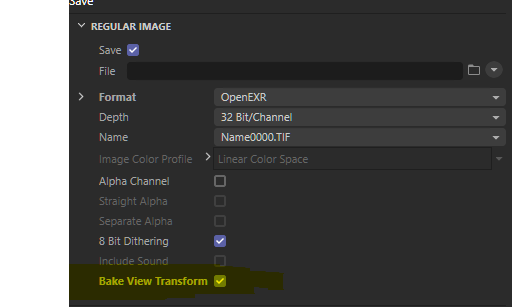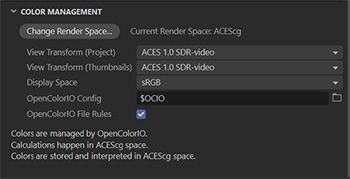Hi
We will not go on wild goose hunts for bugs without clear instructions on what is not working and reproduction steps
At first, I just wanted to know if I am missing any flag/option in the script.
Of course I would have send you repro steps if it turns out to be a bug. But it got into a discussion not about how C4D works, more about how OCIO should work.
You actually have to cooperate with us
I am trying. But it is difficult.
You are telling me again and again that I do not know anything about OCIO!
Have you thought that what you stated might be slightly wrong?
e.g. your first statement that started the theory versus reality discussion:
A rendering does not contain the view transform, as this would basically be against everything OCIO is about
As I cannot argue with information. Simple Repro steps to show why I told you you are not 100% right:
- Open C4D, new scene.
- Add some object.
- Set a filename for "Regular Image", but keep all other settings to the default.
- Render to disk in any way.
- The View Transform is baked. And I have NOT enabled any setting. This is the default behavior of C4D. And you cannot disable it.
Cinema 4D is not baking in the view transform everywhere
As you can see in this example.
Back to the main issue "script versus other C4D functionality"
Reproduction steps:
250306_OcioScript.zip
- Open the scene.
Render with Baked OCIO:
2) Execute "Render to Picture Viewer" (rename the output).
3) Execute "Add to Render Queue", start it (rename the output).
4) Render via commandline (rename the output).
Render without Baked OCIO:
5) Execute the script (rename the output).
Request:
No matter how C4D saves a rendered frame, the file written should always look the same.
refuse to read
which will also explain you what a view is
OK, If you want to hear it from me: The view transform was "invented" to mimic a different display type like a movie screen. This is done not only to have the option to export it for different devices, it is done to have a more physical correct compositing as well (linear space).
But - as I already stated - within your pipeline only (Your OCIO graph columns Texturing, Rendering, Editing).
Not for the final image (column Products).
About your OCIO knowledge:
Let me ask you a question about the OCIO graph you posted: In the third column "Editing" you see the last box states the render in ACEScg. A customer can not display an ACEScg image on his screen. Just try to upload an ACEScg image to Youtube, use it on any website, burn it on a blueray, ...
In your graph: The editing ACEScg box is linked into a "sRGB" and "DCI-P3" color space. How do you think ACEScg is converted into sRGB? You have to bake a transform into the final image.
continue with wild statements ("everything is broken")
That was a simple conclusion....
I never assumed that anyone thinks the right answer is "everything is broken" to the issue.... I simply showed you the alternatives.
Let me explain: You state that it does not make any sense that the view transform is baked into the frame. It is wrong to do that. It should never be applied. So such a behavior is a bug in your eyes. And I took this statement and refer to it as "broken".
BUT: C4D does that by default.
And you cannot disable it (for 8bit output).
And that gets to the conclusion:
A) Either C4D does it wrong since forever (bug/broken).
It should not bake the view transform.
B) C4D does it right.
There is a good reason C4D bakes the view transform.
Customers creates a new scene, renders it and the image saved is the same as he has seen in C4D.
And that leads to the fact that the script render does it wrong.
You did not even mention that you have one of the baking options enabled
I did not enable anything.
C4D default


